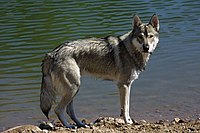Tamaskan Dog: Difference between revisions
→External links: This site is now a personal breeder's website, not a National Club. |
Undid Vandalism from Weakopedia 350746281 by Weakopedia (talk) |
||
| Line 3: | Line 3: | ||
| akcgroup = |
| akcgroup = |
||
| akcstd = |
| akcstd = |
||
| altname = Aatu Tamaskan, Tamaskan Koira |
|||
| ankcgroup = |
| ankcgroup = |
||
| ankcstd = |
| ankcstd = |
||
Revision as of 14:41, 20 March 2010
| Tamaskan Dog | |||||||||||||||||||||||||||||||||
|---|---|---|---|---|---|---|---|---|---|---|---|---|---|---|---|---|---|---|---|---|---|---|---|---|---|---|---|---|---|---|---|---|---|
 A Tamaskan Dog | |||||||||||||||||||||||||||||||||
| Other names | Aatu Tamaskan, Tamaskan Koira | ||||||||||||||||||||||||||||||||
| Common nicknames | Tam, Tamaskan Husky | ||||||||||||||||||||||||||||||||
| Origin | Finland | ||||||||||||||||||||||||||||||||
| Breed status | Not recognized as a breed by any major kennel club. | ||||||||||||||||||||||||||||||||
| |||||||||||||||||||||||||||||||||
| Dog (domestic dog) | |||||||||||||||||||||||||||||||||
The Tamaskan Dog is a breed of domestic dog originating from Finland. It is known to excel in agility, obedience and working trials. It is also capable of pulling sleds, which is inherited from its Siberian Husky and Alaskan Malamute ancestors. Morphologically, Tamaskans have been bred to look like wolves and have a notable lupine appearance. Though still very rare, with less than 5000 registered Tamaskans worldwide, increasing interest in the breed has resulted in the importation of Tamaskans in continental Europe, the UK and the USA, as well as Australia.[1]
Description
Tamaskans are large, athletic dogs; slightly taller in size than German Shepherds. They are substantially larger than their Siberian Husky ancestors but significantly smaller than the Alaskan Malamute. On average, Tamaskan adults measure around 24-28 inches (60–70 cm) tall at the shoulder and typically weigh between 55-88 pounds (25–40 kg). Females are usually slightly smaller and lighter than males, with a distinct feminine appearance. Males are more heavyset with broader heads and a heavier bone structure. Tamaskans have a lupine appearance with a straight bushy tail and thick double coat that comes in three main colors: Wolf Grey, Red Grey, and Black Grey. Each individual guard hair is Agouti banded along its length. The almond-shaped eyes are yellow through amber and brown, with lighter colored eyes being very rare. Blue eyes are unacceptable, as are mismatched eyes.[2]

Temperament
Tamaskans are highly intelligent and have been known to excel in agility, obedience and working trials. They also make good sled dogs and many Tamaskans living in colder climates are regularly used for recreational, and occasionally competitive, dogsled racing as well as skijoring. They make excellent search and rescue dogs due to their keen sense of smell, stamina and endurance. Tamaskans can also be successfully trained as therapy or assistance dogs due to their friendly and laid-back personality. As a breed they are very social and are good with people, children, and other dogs, as well as other small pets (cats, chickens, rabbits, hamsters, parakeets, etc). However, Tamaskan Dogs do not cope well without company and if left alone for long periods of time they may become bored, which can lead to destructive behavior and/or escape attempts. Unlike some of their husky ancestors, Tamaskans respond well off the leash and, with a small amount of training, will return when called.[3]

Health
Tamaskans are generally very healthy with only a few serious health issues that only affect a very small percentage of the breed overall. Roughly 10% of males, as with all other dog breeds, suffer from monorchidism: the state of having only one testicle within the scrotum. Epilepsy has been diagnosed in two dogs, affecting less than 1% of all registered Tamaskans worldwide. As with all large breed dogs, hip dysplasia is a risk; however, due to the work of the TDR and strict health requirements, which ensure that only dogs with good hip scores are allowed to breed, this risk has been greatly reduced.[4]

History
The first generation of Tamaskan Dogs to be registered were born in 2002. Since that time the founders have continued to search for "wolfy looking" dogs to improve the breed. The last foundation dog was added to the breed in 2006, when the doors were closed to new bloodlines. The breeds used include Northern Inuit, Utonagan, Siberian Husky, Alaskan Malamute, German Shepherd and Finnish racing huskies (unregistered huskies and husky crosses bred for competitive sled racing in Lapland). Each dog was carefully selected for its appearance, intelligence, temperament and health.[5]
The first Tamaskans to be imported into America arrived in 2005 and they had their first litter in 2007. Since that time the Tamaskan's popularity has grown exponentially and there are now several TDR-registered breeders across America.[6]
The Tamaskan Dog Register (TDR) consists of an international committee and is the official Governing Body for all Tamaskan Dogs worldwide. The TDR maintains the pedigree and health records for all authentic, registered Tamaskans. The Tamaskan Dog Society of Great Britain (TDSGB), the National Tamaskan Club of America (NTCA), Euro Tamaskan and The Tamaskan Dog Showing Club are all affiliated with the TDR.[7]
References
- ^ It’s Not a Wolf, It’s a Tamaskan! January 2008
- ^ Tamaskan Pictorial Standard January 2005
- ^ Tamaskan Dog Breed Info June 2006
- ^ Tamaskan Health Database March 2009
- ^ Tamaskan Dog Standard August 2008
- ^ The Tamaskan Dog February 2007
- ^ Tamaskan Dog November 2006
- The Florida Lupine News Volume 9 Issue 3 (Autumn 2007)
- Animal Wellness Magazine 7447079635 Volume 10 Issue 1 (Feb-Mar 2008)
- Dogs Monthly - March 2009 Issue
- Dogs Today - July 2009 Issue
- Dogs Today - Nov 2009 Issue (front cover)
